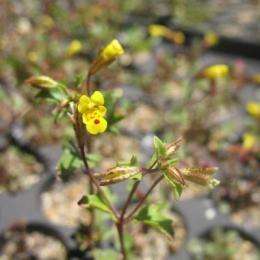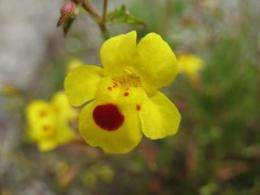Gene flow may help plants adapt to climate change

The traffic of genes among populations may help living things better adapt to climate change, especially when genes flow among groups most affected by warming, according to a UC Davis study of the Sierra Nevada cutleaved monkeyflower. The results were published online June 27 by the journal Proceedings of the National Academy of Sciences.
The findings have implications for conservation strategies, said Sharon Strauss, professor of evolution and ecology at UC Davis and an author of the study.
"In extreme cases where we might consider augmenting genetic resources available to imperiled populations, it might be best to obtain these genes from populations inhabiting similar kinds of habitats," Strauss said.
Graduate student Jason Sexton, with Strauss and Kevin Rice, professor of plant sciences, studied the monkeyflower (Mimulus laciniatus), an annual plant that lives in mossy areas of the Sierra at elevations of 3,200 feet to 10,000 feet.
Mountain gradients are useful for studying the effects of climate change, Strauss said, because they enable scientists to reproduce the effects of climate change without changing other factors, such as day length. The plants are already living across a range of temperatures, with those at lower elevations exposed to warmer conditions.
Sexton cross-pollinated monkeyflowers from two different locations at the warm, low-elevation edge of the plants' range with monkeyflowers from the middle of the range. All the hybrids were then grown in the field at the low end of the range.

As the researchers observed the growing monkeyflowers, they were able to test two contrasting predictions about how gene flow should affect plants at the edge of the range. The first prediction was that any mixing of genes from a wider population would help plants adapt to warming conditions. The second was that genes from the center of the range that did not help plants adapt would dilute any adaptive genes, negating their benefit.
"Gene flow" describes the movement of genetic traits within and among populations, as individual animals or plants breed.
To answer these questions, the researchers measured how the mixing of genes from different elevations affected the plants' ability to live at the warm edge of their range, through traits such as time for seedlings to emerge, time to flowering and overall reproductive success.
The study showed that the first prediction was true – gene flow did help the plants adapt to a warmer environment.
"We generally found that there were benefits from gene flow, but gene flow from other warm-edge areas was most beneficial," Strauss said.
Sexton noted that hybrids of monkeyflowers from two warm-edge populations did better than either of their parents, perhaps because the populations had been using different genes to adapt to warm environments.
"When added together, their performance jumped," he said.
Often considered genetically meager, edge populations should be high-priority conservation targets since they may possess adaptations to their unique environments, Sexton said.
Provided by University of California - Davis
















